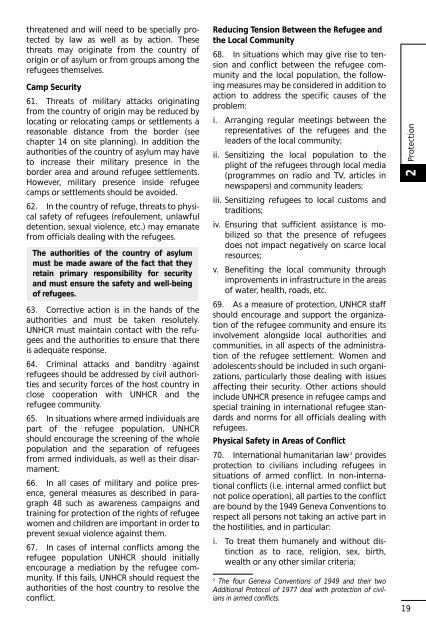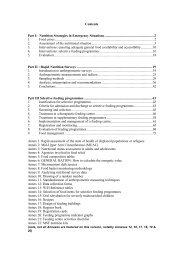UNHCR Handbook for Emergencies - UNHCR eCentre
UNHCR Handbook for Emergencies - UNHCR eCentre
UNHCR Handbook for Emergencies - UNHCR eCentre
You also want an ePaper? Increase the reach of your titles
YUMPU automatically turns print PDFs into web optimized ePapers that Google loves.
threatened and will need to be specially protected<br />
by law as well as by action. These<br />
threats may originate from the country of<br />
origin or of asylum or from groups among the<br />
refugees themselves.<br />
Camp Security<br />
61. Threats of military attacks originating<br />
from the country of origin may be reduced by<br />
locating or relocating camps or settlements a<br />
reasonable distance from the border (see<br />
chapter 14 on site planning). In addition the<br />
authorities of the country of asylum may have<br />
to increase their military presence in the<br />
border area and around refugee settlements.<br />
However, military presence inside refugee<br />
camps or settlements should be avoided.<br />
62. In the country of refuge, threats to physical<br />
safety of refugees (refoulement, unlawful<br />
detention, sexual violence, etc.) may emanate<br />
from officials dealing with the refugees.<br />
The authorities of the country of asylum<br />
must be made aware of the fact that they<br />
retain primary responsibility <strong>for</strong> security<br />
and must ensure the safety and well-being<br />
of refugees.<br />
63. Corrective action is in the hands of the<br />
authorities and must be taken resolutely.<br />
<strong>UNHCR</strong> must maintain contact with the refugees<br />
and the authorities to ensure that there<br />
is adequate response.<br />
64. Criminal attacks and banditry against<br />
refugees should be addressed by civil authorities<br />
and security <strong>for</strong>ces of the host country in<br />
close cooperation with <strong>UNHCR</strong> and the<br />
refugee community.<br />
65. In situations where armed individuals are<br />
part of the refugee population, <strong>UNHCR</strong><br />
should encourage the screening of the whole<br />
population and the separation of refugees<br />
from armed individuals, as well as their disarmament.<br />
66. In all cases of military and police presence,<br />
general measures as described in paragraph<br />
48 such as awareness campaigns and<br />
training <strong>for</strong> protection of the rights of refugee<br />
women and children are important in order to<br />
prevent sexual violence against them.<br />
67. In cases of internal conflicts among the<br />
refugee population <strong>UNHCR</strong> should initially<br />
encourage a mediation by the refugee community.<br />
If this fails, <strong>UNHCR</strong> should request the<br />
authorities of the host country to resolve the<br />
conflict.<br />
Reducing Tension Between the Refugee and<br />
the Local Community<br />
68. In situations which may give rise to tension<br />
and conflict between the refugee community<br />
and the local population, the following<br />
measures may be considered in addition to<br />
action to address the specific causes of the<br />
problem:<br />
i. Arranging regular meetings between the<br />
representatives of the refugees and the<br />
leaders of the local community;<br />
ii. Sensitizing the local population to the<br />
plight of the refugees through local media<br />
(programmes on radio and TV, articles in<br />
newspapers) and community leaders;<br />
iii. Sensitizing refugees to local customs and<br />
traditions;<br />
iv. Ensuring that sufficient assistance is mobilized<br />
so that the presence of refugees<br />
does not impact negatively on scarce local<br />
resources;<br />
v. Benefiting the local community through<br />
improvements in infrastructure in the areas<br />
of water, health, roads, etc.<br />
69. As a measure of protection, <strong>UNHCR</strong> staff<br />
should encourage and support the organization<br />
of the refugee community and ensure its<br />
involvement alongside local authorities and<br />
communities, in all aspects of the administration<br />
of the refugee settlement. Women and<br />
adolescents should be included in such organizations,<br />
particularly those dealing with issues<br />
affecting their security. Other actions should<br />
include <strong>UNHCR</strong> presence in refugee camps and<br />
special training in international refugee standards<br />
and norms <strong>for</strong> all officials dealing with<br />
refugees.<br />
Physical Safety in Areas of Conflict<br />
70. International humanitarian law 2 provides<br />
protection to civilians including refugees in<br />
situations of armed conflict. In non-international<br />
conflicts (i.e. internal armed conflict but<br />
not police operation), all parties to the conflict<br />
are bound by the 1949 Geneva Conventions to<br />
respect all persons not taking an active part in<br />
the hostilities, and in particular:<br />
i. To treat them humanely and without distinction<br />
as to race, religion, sex, birth,<br />
wealth or any other similar criteria;<br />
2 The four Geneva Conventions of 1949 and their two<br />
Additional Protocol of 1977 deal with protection of civilians<br />
in armed conflicts.<br />
Protection<br />
2<br />
19



